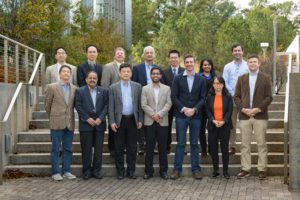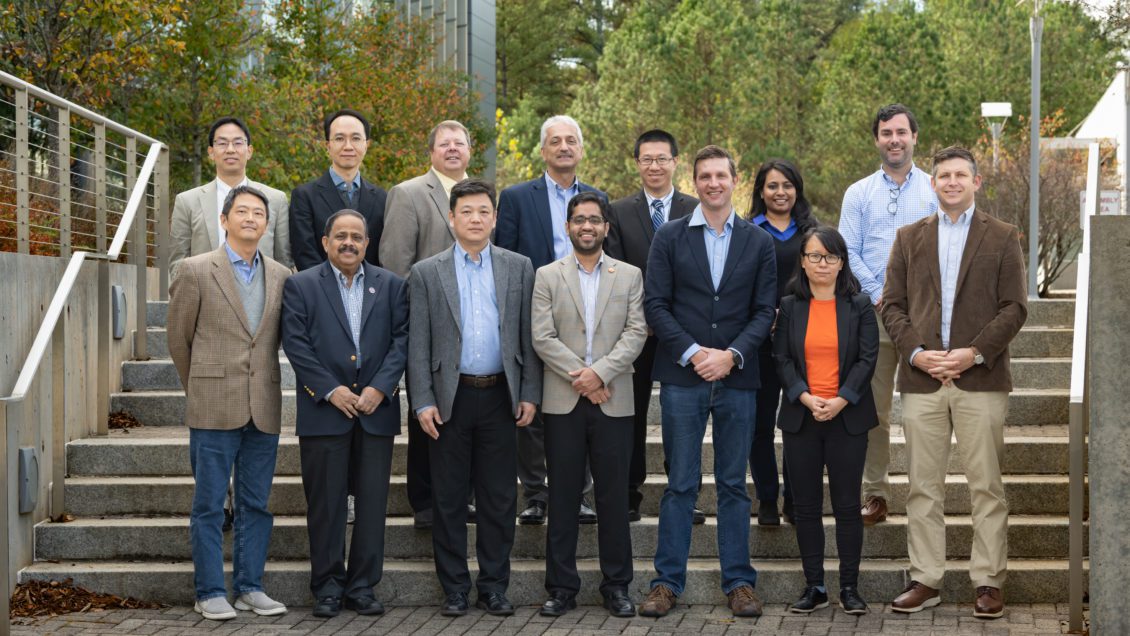A new Clemson University center is bringing together researchers from across the country to develop a transformational method for creating composite materials, an approach that could help manufacturers save time, money and energy while leaving less of an environmental footprint.
Srikanth Pilla, the Robert Jenkins Endowed Professor of Automotive Engineering, is the principal investigator on the new center, called Artificially Intelligent Manufacturing Paradigm for Composites (AIM for Composites).

Those pictured in the top row are (from left to right): Yong Huang, Taejoon Park, Kevin Simmons, Farhang Pourboghrat, Zhen Li, Megha Patel and Dale Hitchcock. Those pictured in the bottom row are (from left to right): Feng Luo, Nikunja Swain, Gang Li, Srikanth Pilla, Mik Carbajales-Dale, Qiong Zhang and James Sternberg.
The center will receive $10.35-million in support from the U.S. Department of Energy’s Office of Science.
Organizations partnering on the project include Brown University, Ohio State University, University of Florida, South Carolina State University, Pacific Northwest National Laboratory, and Savannah River National Laboratory.
AIM for Composites could have a major long-term impact on how manufacturers in a wide range of industries create composite-material components that go into final products, such as cars and airplanes.
In the near-term, the center itself will create about 15 research jobs for postdoctoral fellows and graduate students, as well as administrative staff to support the team. Also, the center is advertising to hire a newly created diversity, equity and inclusion (DEI) and outreach manager that will be based in Greenville.
Clemson President Jim Clements said the grant is a testament to the University’s leadership in composite-material innovation and the field’s next-generation workforce.
“We are honored that the Department of Energy has selected Clemson to lead this nationwide initiative. The center’s researchers will have a major impact on advanced-materials, advanced-manufacturing research, and in broadening and diversifying talent across academia and into the workforce,” Clements said. “I also want to offer my sincerest congratulations to the team leading this effort. Their vision for connecting top priorities is to be commended, and I know they will excel in leading this high-impact center.”
Manufacturers use composite materials because they can be created to perform better than standard materials. Some automotive components, for example, are made from composite materials because they are lighter yet stronger than steel, and the weight reduction allows vehicles to travel farther on less energy.
The center’s researchers are working to flip the process for making composite materials on its head.
Composite materials are usually developed through trial-and-error, a process that can be expensive and time consuming. Researchers combine two or more materials to create the composite material and then test it for various properties, such as weight, strength and stiffness.
Instead, researchers are developing a system that would allow manufacturers to tell a computer what performance their product must meet. Then, through artificial intelligence and a technique called inverse engineering, the computer would reply with how to make the composite material, including which feedstock to use and what manufacturing processes would create the desired properties.
Artificial intelligence will be trained to factor in energy use, economic considerations and environmental impact, an approach researchers are calling E3.
Pilla said AIM for Composites underscores that the University has made major breakthroughs in fundamental composite-materials research and sets the stage for an even bigger impact.
“For manufacturers, this is going to provide a great resource,” he said. “In the future, they will ask for quantitative and qualitative metrics, then they will feed the metrics into the platform, and it will provide a recipe for how to make the composite material. It will likely disrupt how the development of new materials is seen in the composites community.”
The center will develop a detailed strategic plan for diversity, equity and inclusion, including research and scholarship opportunities, mentoring, professional guidance and diversity training for the center’s personnel. A Diversity, Equity and Inclusion Advisory Board will help guide the center’s decisions.
Angie Leidinger, senior vice president for external affairs and senior advisor to the Board of Trustees, said AIM for Composites is creating a future workforce for the composite-materials industry.
“This center will provide opportunities for students to learn the most cutting-edge techniques, helping prepare them for some of industry’s most pressing challenges,” she said. “Its plan for diversity, equity and inclusion will help broaden and diversify the talent pipeline.”
Robert Jones, executive vice president for academic affairs and provost, said AIM for Composites is fertile ground for convergence research and exemplary educational experiences.
“With this grant, students, faculty and postdoctoral fellows from across the country are coming together for multidisciplinary research that addresses real-world challenges in industry and academia,” Jones said. “We are excited that Clemson is in the lead on composite materials research and education, and I congratulate all involved on the grant.”
Laine Mears, chair of the Department of Automotive Engineering at Clemson, said Pilla is well positioned to lead the center. In addition to serving as founding director of AIM for Composites, Pilla is founding director of the Clemson Composites Center. He led a project to create an ultralight vehicle door that was recognized last summer with a Team Award from the Department of Energy’s Vehicle Technologies Office.
“Srikanth has staked out a reputation as one of the globe’s leading composite materials researchers,” Mears said. “AIM for Composites extends his platform and positions him to have an even larger impact in the future. This is a win-win for our students and industry.”
Anand Gramopadhye, dean of the College of Engineering, Computing and Applied Sciences, said the center will help enable impactful research and educational experiences.
“AIM for Composites plays a major role in establishing the college as a national leader in multidisciplinary research into sustainable-energy technologies that help support competitiveness in advanced manufacturing,” he said. “The center sets the stage for innovation and will help create the next generation of leaders, innovators and entrepreneurs. I congratulate the team on a job well done.”
This research was supported as part of the AIM for Composites, an Energy Frontier Research Center funded by the U.S. Department of Energy, Office of Science, Basic Energy Sciences (BES), under Award #DE-SC0023389.
Get in touch and we will connect you with the author or another expert.
Or email us at news@clemson.edu

